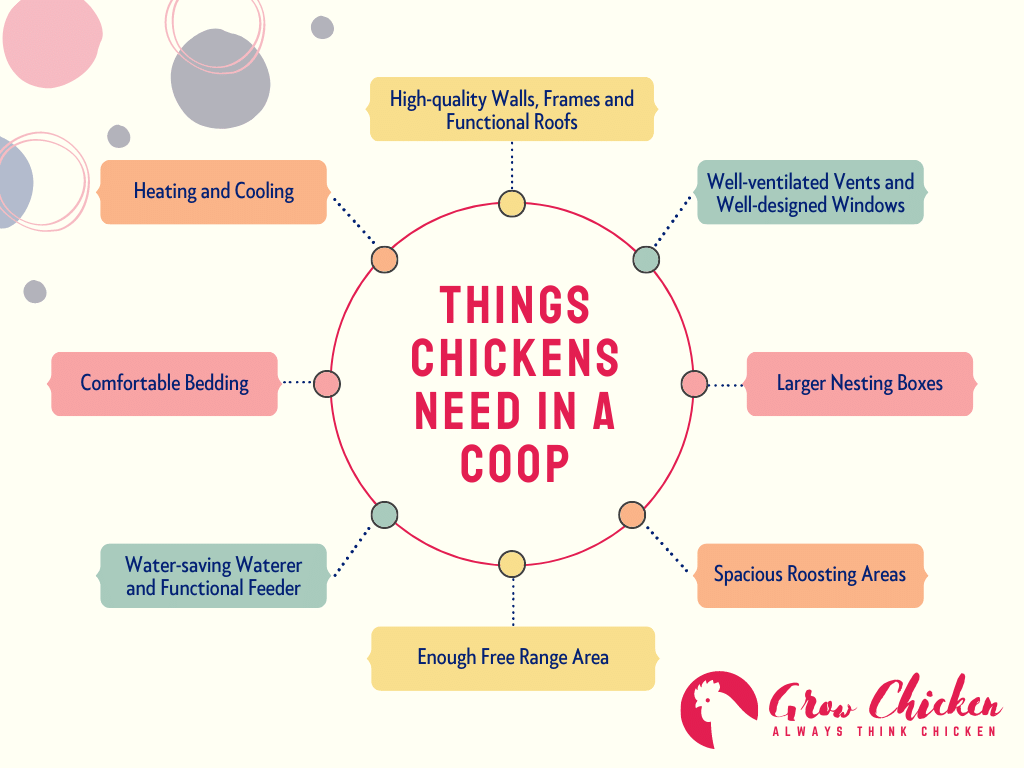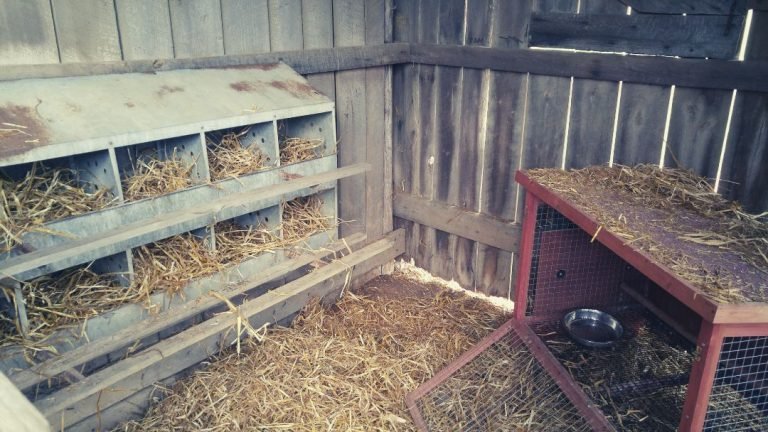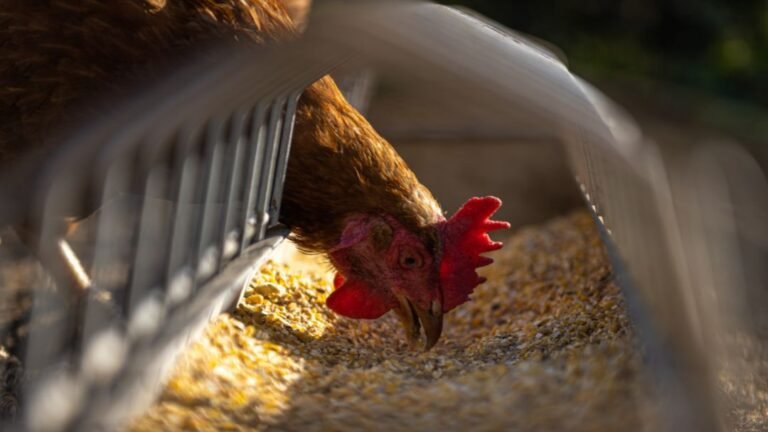Like human beings, chickens also need some basic things in their house. It allows them to lead a comfortable, peaceful, and happy life. Some items are not mandatory. But to ensure their optimal growth, keeping all essentials inside the flock house is crucial.
What do chickens need in a chicken coop? A chicken coop needs high-quality walls and frames, a functional roof, well-ventilated vents, well-designed windows, larger nesting boxes, spacious roosting areas, enough free range area, water-saving waterers, functional feeders, sufficient heating and cooling, and toys for entertainment.
Essential Things Chickens Need In A Coop
Making four-sided walls is enough for chickens.
You want to add some essential things to create a better ecosystem inside the chicken coop.
The following are the crucial things a flock house needs.

High-quality Walls and Frames
The first important decision is determining how many chickens you will raise. You can either make a DIY chicken coop or buy a readymade option.
DIY options are a better choice to customize based on your flock’s needs. However, whether you buy it or make it, it must have four walls and a solid roof.
Keeping 3-4 square feet of space per chicken is a solid rule of thumb.
The wall should be made from naturally rot-resistant wood. It can be redwood, cedar, or tropical hardwood.
Metal frames come in handy for optimal protection and easy cleaning. They have a solid construction to prevent predators and insects from harming your chickens.
Functional Roof
Shingles, plastic, and metal are the top choices for the roof material of chicken coops.
If you prefer the best weather, fire, or wind-resistant option, Shingle is the best choice. However, it is pretty expensive and complicated to install.
Nevertheless, it adds long-term value to your chicken coop. Most importantly, shingle roofing provides excellent protection against predators.
Another handy option is corrugated metal. They are super strong. Even hail stones are unlikely to damage the flock house.
One of the key advantages of the metal-based coop is that they don’t hold heat like other roofing materials. Your chickens won’t have to wait longer to cool themselves.
Plastic roofing is a good choice if you prefer to create a disease-free environment. It is pretty affordable too.
However, plastic roofing is not the best choice for extreme weather conditions. Too much hot or cold weather may affect its durability over time.
Well-ventilated Vents
Ventilation is a must for chickens. It is a good rule of thumb to ensure 3-4 sqft. of ventilation for each bird.
Chicken keepers achieve this objective by installing several vents. Adjustable flaps or sliding covers are the best ventilation options for flocks.
They offer a good amount of air to go through. Another plus point of the metal frame is that they are not prone to hold heat like wood
Opening and closing the vents is easygoing. However, ensure they are tight enough to prevent excessive wind from entering the coop.
Otherwise, carbon dioxide and ammonia fumes will get inside the chicken house.
If too much air still enters the coop, use weldmesh or hardware cloth to restrict airflow.
Make sure to install them just below the roofing area. It could be just a few inches of gap between the roofing edge and the vents.
Well-designed Windows
Many new chicken keepers sometimes think windows are not mandatory for chicken coops. At least two windows on the opposite side of the chicken coop are essential.
But which chicken coop must have windows? It lets enough sunlight enter the flock’s house.
After all, keeping birds in 14-16 hours of daylight is crucial. It ensures optimal growth and better egg production.
Wood, aluminum, polycarbonate, and vinyl are some commonly used materials for windows. But plywood is one of the best choices for chicken coop windows.
You can install various styles of windows, such as slides, casements, hoppers, awnings, etc.
If there are any probabilities of dangerous predators, use a transparent, red, or opaque plastic sheet or Wire mesh to cover the entire window.
Larger Nesting Boxes
Nesting boxes are essential to allow chickens to lay eggs conveniently. More importantly, you can collect eggs quickly without searching for hours.
The main advantage of nesting boxes is providing flocks with enough privacy and safety.
Keeping several chickens in a single box is okay. But don’t overdo it. Generally, each nesting box can accommodate four chickens.
Avoid keeping too many birds in a single option. It will lead to trouble if they are pretty aggressive.
You can use Constructing boxes to save cost. But, they need to be specious enough to accommodate all chickens.
Make several partitions to create separate spaces. It comes in handy to prevent a fight between aggressive breeds.
Using separate chicken boxes for broody hens is a solid rule of thumb. Cypress, redwood, or cedar boards are great choice nesting boxes. But make sure they are at least ¾ inches thick.
Spacious Roosting Areas
Chickens don’t prefer to sleep on the ground. It is harmful to them too. Bacteria and parasites may attack them continuously.
Flocks love to sleep in an elevated space, which we often call roosting bars. Ensuring enough space for each bird is crucial.
Generally, a small chicken needs around 8 inches of space, whereas heavier breeds need 10 inches. But maintaining 12 inches of space is better.
The roosting bars can be round or square. Round or oval-shaped options offer more comfort to chickens’ feet.
But if you want to use square or rectangular options, trim the edges to create a round one.
Besides, keeping at least an eighteen-inch or higher gap from the coop floor is a solid rule of thumb. But, its height can be up to 3 feet depending on the roof height.
To make several roosting bars, you can use sturdy wooden boards, branches, or ladder boards.
Enough Free Range Area
Sometimes, your backyard may not have enough space to accommodate enough free-range area outside the chicken coop.
The best thing you can do is create a spacious environment by building a multi-level flock house.
Adding enough space inside the chicken coop allows birds to wander freely without disturbing each other.
It allows shy or calm breeds to stay safe from aggressive chickens. They can live happily in their territory.
It comes in handy during the cold and rainy season when flocks can’t go outside. They can keep themselves busy while staying inside.
Water-saving Waterer
Chickens usually drink 0.5 liters of water daily. But it can depend more or less on their breed type and weather.
But what should you use to feed water flocks? Using troughs, cups, or buckets is okay if your chickens are calm.
However, this open-water system can spill water and ruin the chicken floor. Plus, water becomes dirty quickly from feathers, feces, or dust. You have to clean it regularly. So you should go for water-saving waterers.
The best option is nipple drinkers. Due to its enclosed system, chickens can’t make the water dirty and spill water on the floor.
Whenever flocks like to drink water, they will peck on the edge, and water will start coming in small quantities.
Functional Feeder
Chicken feeders come in various types, such as bells, treadles, tube pipes, galvanized gravity-fed, flip-top troughs, tank stands, hoppers, etc.
If you only grow heavy breeds and don’t have time to refill foods daily, tank-stand Chicken Feeders are a great choice.
Make sure to keep five centimeters of feeder space for each chicken. You can use a plastic- or metal-based chicken feeder.
Plastics are great choices because they are not prone to rust and corrosion. Plus, this material is chemical-resistant and non-porous.
When it comes to durability, metal is the best choice. But they are slightly more expensive than plastics.
Comfortable Bedding
It is crucial to use comfortable bedding material to maintain a clean and moisture-free environment.
Many chicken keepers prefer Wood shavings as they are readily available and affordable. Also, you have to ensure the right amount of bedding.
However, they need regular replacement. On top of that, some release dust that can harm flocks.
It is best to use medium- to coarse-grained sand. After all, they dry quickly and don’t have any toxic ingredients.
In addition, good quality sands have a minimal level of dust.
Heating and Cooling
Some chickens are cold-tolerant, and some are heat-tolerant. But most chickens can endure extreme heat and cold conditions.
If the temperature exceeds 90-100 degrees Fahrenheit, it may cause heat stress problems. Flocks may catch various illnesses if they continue for several weeks.
You can use misting attachments or fans to reduce the temperature.
More importantly, it will prevent high humidity levels. Otherwise, you may see frostbite or other illness.
Chickens can endure as low as minus 20 degrees Fahrenheit. If it goes beyond the point, flocks will start suffering. Consider insulating the chicken coop for the extreme winter seasons.
Experts recommend not using any heat lamps and maintaining a heat lamp schedule, because they can overheat flocks. Instead, you can use radiant, flat panels or sweeter heaters, check here.
This type of heater doesn’t heat the entire chicken coop. Instead, they deliver hot air to flocks that have closed the device.
Toys for Entertainment
We all love to entertain ourselves. So, why not chickens? They have a playful nature.
Adding some toys will keep them busy inside the chicken coop. This comes in handy during extreme weather conditions.
Toys are not only a source of fun for chickens. Also, it stimulates their overall growth as flocks stay busy continuously.
But, you must be wondering what toys chicken will like, right? Chicken keepers can use many homemade items as chicken toys.
For example, an empty plastic bottle with holes, boxes of shredded paper, or leaves with poultry food can be a simple playing object.
However, if you prefer a little bit better option, chicken swings are a great choice. Alternatively, babies’ old toys will not be nasty too.
Final Thoughts
Are you still wondering about this question: What do chickens need in a chicken coop? Flocks need many items in their house to stay happy, comfortable, and fit.
Some items might not be mandatory to add. But they can keep chickens healthy and contribute to better meat and egg production.
Make sure to consider your chicken coop nature and breed before choosing any items. You should aim at giving long-term value.



